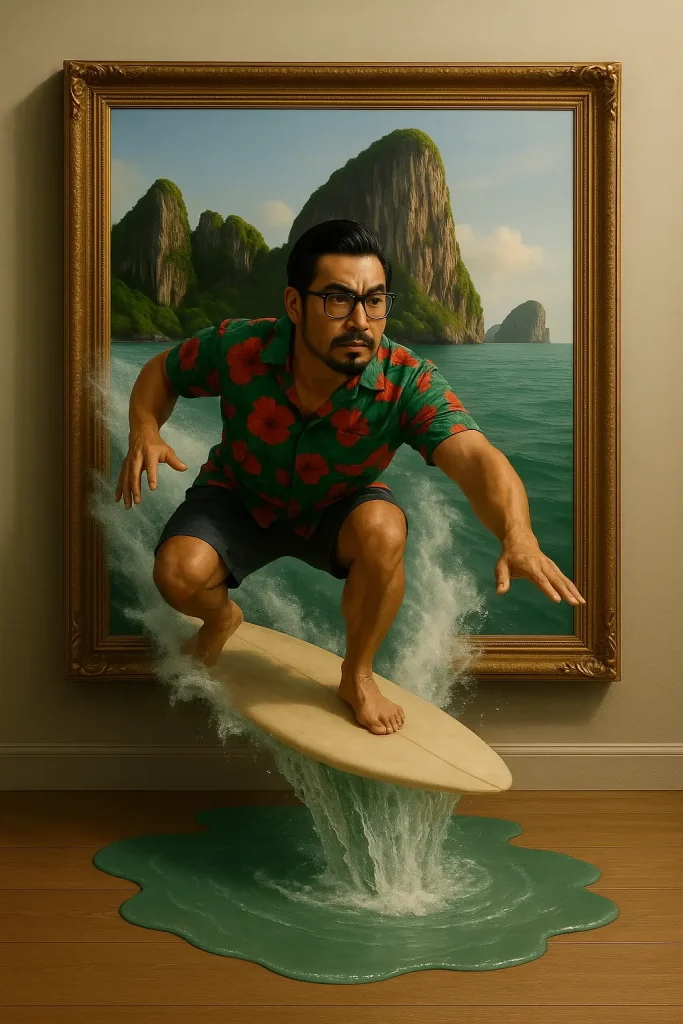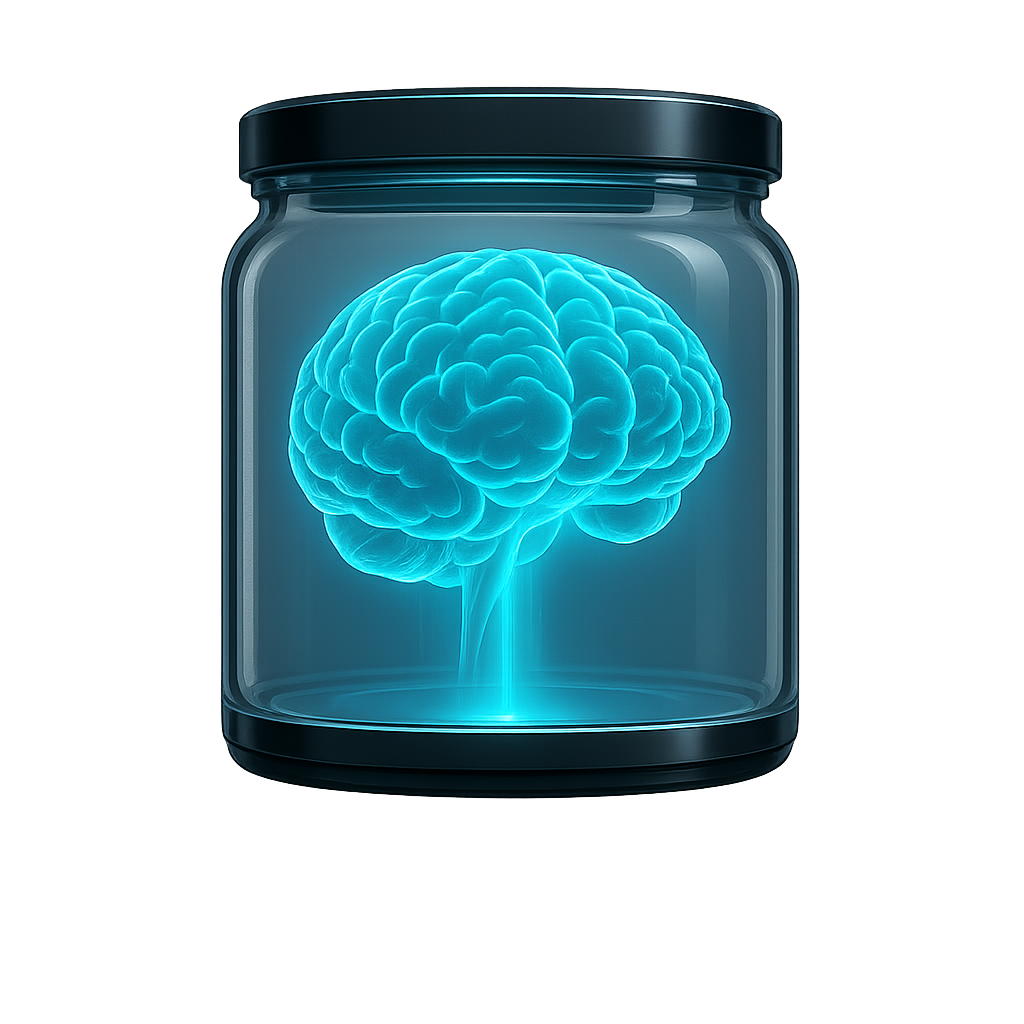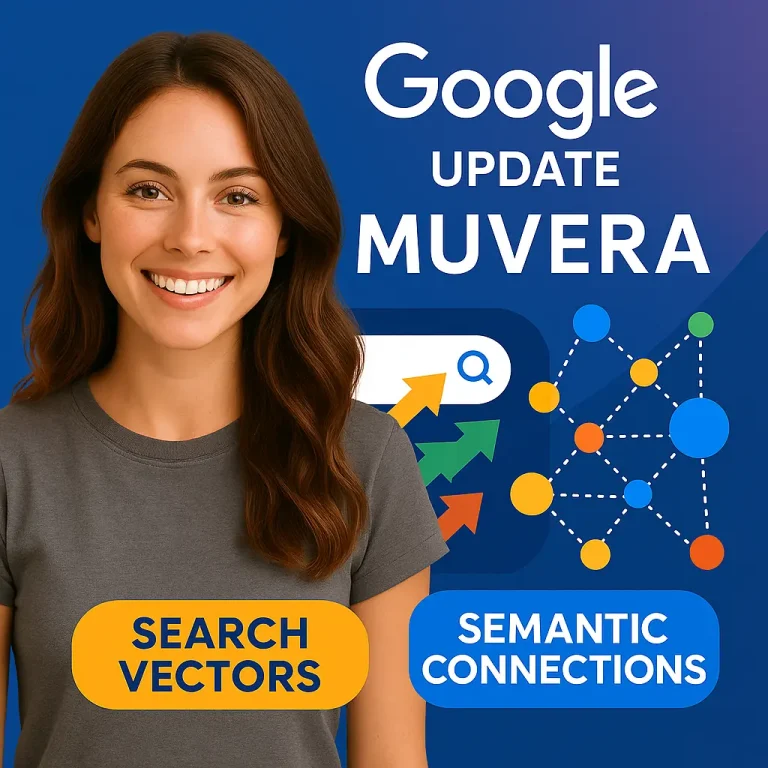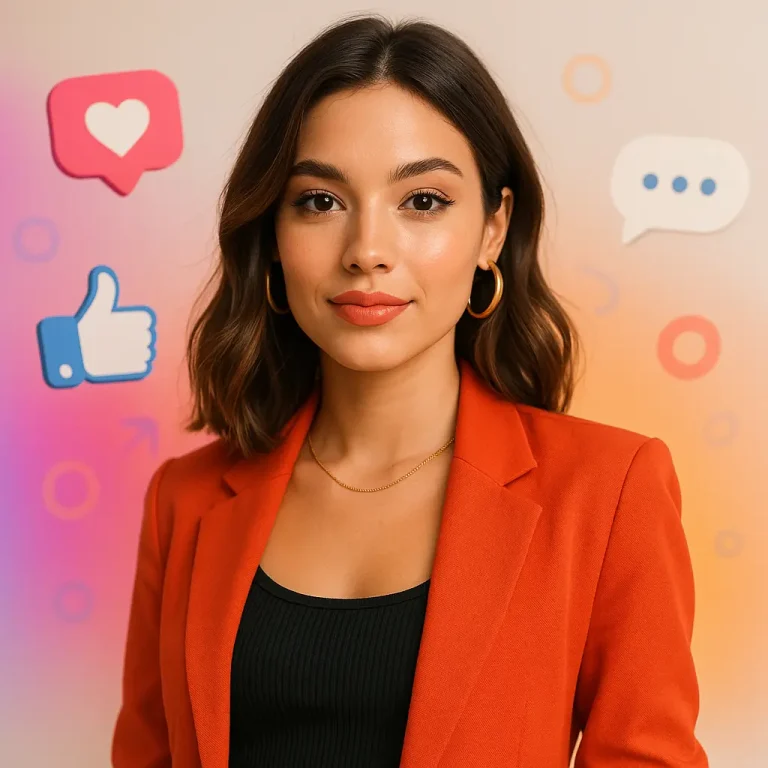
This analysis examines a striking example of AI-generated trompe-l'œil art featuring a surfer appearing to break through the boundaries of a framed artwork onto a physical floor. Through systematic deconstruction of visual elements, artistic techniques, and prompt engineering principles, we can reconstruct the likely text prompt used to generate this compelling optical illusion that seamlessly blends digital artistry with three-dimensional spatial effects.
Understanding Trompe-l'œil in AI Art Generation
Trompe-l'œil, French for “deceive the eye,” represents a sophisticated artistic technique that creates optical illusions of three-dimensional reality on two-dimensional surfaces. In the context of AI image generation, this technique has gained significant popularity as creators seek to produce viral content that challenges viewers' perception of reality. The effectiveness of trompe-l'œil in AI art depends heavily on specific prompt engineering techniques that guide the model to understand spatial relationships, lighting effects, and the crucial interaction between fictional and real-world elements.
Modern AI image generators excel at creating these illusions when provided with detailed instructions about perspective, depth, and the breaking of traditional frame boundaries. The technique requires careful attention to lighting consistency, shadow placement, and the seamless integration of elements that appear to exist both within and outside the depicted fram. Research into viral AI art trends shows that “out of bounds portraits” and similar trompe-l'œil effects have become increasingly popular on social media platforms, with creators specifically seeking prompts that can generate these eye-catching visual effect.
The technical execution of trompe-l'œil in AI art involves sophisticated understanding of spatial relationships, where the AI must comprehend not only the subject matter but also its interaction with implied real-world space. This requires prompts that explicitly describe the transition from two-dimensional artwork to three-dimensional reality, including specific details about how elements like water, objects, or figures appear to spill or emerge from their constrained artistic boundaries.
Deconstructing the Visual Elements
Subject and Character Analysis
The central figure in this artwork is a man wearing distinctive eyeglasses and a vibrant tropical shirt featuring red hibiscus flowers against what appears to be a teal or dark green background. His positioning on the surfboard demonstrates dynamic movement, with arms extended for balance in a classic surfing stance. The character's casual beach attire and confident posture suggest this is meant to represent an everyday surfer rather than a professional athlete, making the image more relatable and accessible to viewers.
The facial features and body language convey a sense of joy and freedom associated with surfing culture. The glasses add an interesting contrast to the typical surfer stereotype, suggesting this could represent the “everyman” surfer or perhaps hint at a more intellectual or artistic interpretation of the sport. The detailed rendering of the clothing texture, particularly the hibiscus pattern, indicates that the original prompt likely included specific descriptions of tropical or Hawaiian-style clothing elements.
The figure's positioning relative to the surfboard and the breaking wave demonstrates sophisticated understanding of surfing dynamics. The AI has successfully captured the essential elements of surfing posture, including the slightly crouched stance, extended arms for balance, and the natural interaction between surfer and board that would be necessary for effective wave riding.
Environmental and Background Details
The background reveals a stunning tropical seascape featuring dramatic limestone karst formations reminiscent of locations like Thailand's Krabi province, the Philippines' Palawan region, or Vietnam's Ha Long Bay. These towering rock formations emerge from turquoise waters, creating a sense of exotic adventure and tropical paradise that enhances the overall appeal of the scene. The water displays multiple shades of blue and green, suggesting clear tropical waters with varying depths and light penetration patterns.
The wave dynamics show sophisticated understanding of water physics, with white foam and spray patterns that appear realistic and energetic. The water's interaction with the surfboard creates believable physics, including the spray patterns and wave formation that would naturally occur during active surfing. The lighting throughout the scene appears to be natural daylight, possibly late morning or early afternoon, creating optimal conditions for both surfing and photography.
The sky features soft, wispy clouds that complement the tropical setting without overwhelming the composition. The overall color palette emphasizes blues, greens, and warm earth tones from the rock formations, creating a harmonious and visually appealing environment that supports the central action of surfing.
The Trompe-l'œil Effect Mechanics
The most striking aspect of this artwork lies in its successful execution of the trompe-l'œil illusion, where the surfing scene appears to break free from its artistic constraints and spill into real-world space. The frame itself appears to be a traditional rectangular border, suggesting a painting or print that has somehow come to life. The water spilling onto the wooden floor creates the crucial bridge between the fictional artistic space and the implied real-world environment.

The perspective and spatial relationships demonstrate sophisticated prompt engineering, as the AI has successfully rendered the transition from the two-dimensional artwork space to the three-dimensional floor space. The water pooling on the wooden floor follows realistic physics, with appropriate reflection and transparency effects that enhance the illusion's believability. The shadow casting and lighting consistency between the framed scene and the floor area suggest careful attention to these details in the original prompt.
The breaking of the fourth wall occurs specifically at the bottom edge of the frame, where the water and potentially the surfboard extend beyond the artwork's boundaries. This selective breaking of spatial constraints—maintaining the frame's integrity on three sides while allowing spillage on the fourth—demonstrates the prompt's sophisticated understanding of how to create maximum visual impact while maintaining compositional coherence.
Prompt Engineering Analysis
Core Prompt Structure
Based on established prompt engineering principles and the visual evidence, the original prompt likely followed a structured format beginning with the trompe-l'œil instruction. The prompt would have started with explicit direction for creating an optical illusion effect, possibly using phrases like “trompe-l'œil illusion of” or “3D optical illusion showing”. This foundational element guides the AI to understand that the image should challenge spatial boundaries and create the appearance of three-dimensional interaction.
The subject description would have included specific details about the surfer's appearance, including the eyeglasses, tropical shirt with hibiscus pattern, and surfing posture. Professional prompt engineering practices suggest including details about clothing patterns, accessories, and body language to achieve the level of specificity seen in the final image. The surfboard description would have specified its color and basic design elements to ensure proper rendering within the aquatic environment.
Environmental specifications likely included references to tropical locations, limestone karst formations, and specific water conditions. The prompt would have needed to balance providing enough detail to achieve the desired tropical paradise aesthetic while avoiding over-specification that might confuse the AI or create conflicting visual elements.
Technical Parameters and Style Specifications
The prompt almost certainly included specific technical parameters to achieve the photorealistic quality evident in the final image. Based on current best practices for AI image generation, these would include aspect ratio specifications, style parameters, and quality settings28. The level of detail and realism suggests the use of parameters designed for photorealistic output, possibly including specifications for camera simulation, lighting effects, and texture rendering.
Style specifications would have emphasized the trompe-l'œil technique while ensuring photorealistic execution. This balance between artistic technique and realistic rendering requires careful prompt crafting that guides the AI toward the desired visual effect without sacrificing believability. The successful integration of the water spilling effect suggests specific instructions about the interaction between the framed artwork and the real-world floor space.
Quality and resolution parameters likely emphasized high-detail rendering to support the illusion's effectiveness. Trompe-l'œil effects rely heavily on convincing detail work, particularly in areas where the illusion transitions from artistic space to real space. The wooden floor texture, water reflection effects, and consistent lighting all indicate prompt specifications designed to maximize visual realism and detail clarity.
Reconstructed Prompt Formula
Primary Prompt Construction
Based on the comprehensive visual analysis and established prompt engineering principles, the reconstructed prompt would likely read: “Trompe-l'œil illusion of a man with glasses wearing a red hibiscus tropical shirt surfing on a wooden surfboard, breaking out of a framed tropical seascape painting with limestone karst formations and turquoise water, water spilling onto wooden floor, photorealistic, optical illusion, 3D effect”.
The prompt structure follows established trompe-l'œil AI art formulas that begin with the illusion specification, include detailed subject description, specify the environmental setting, and conclude with technical quality parameters. The inclusion of specific details like the hibiscus shirt pattern and limestone karst formations ensures that the AI generates the distinctive visual elements that make this image compelling and unique.
Additional technical specifications might include parameters for aspect ratio, style settings, and quality enhancement. Many successful trompe-l'œil prompts include specifications like “–ar 16:9 –style raw –v 5.2” or similar technical parameters that optimize the AI's rendering capabilities for this type of optical illusion artwork.
Alternative Prompt Variations
Alternative formulations might emphasize different aspects of the illusion while maintaining the core concept. A more detailed version could specify: “Hyperrealistic trompe-l'œil artwork showing a Hawaiian surfer with eyeglasses and tropical floral shirt riding a surfboard through a framed painting of tropical islands, water cascading onto hardwood floor, 3D optical illusion, photographic quality, breaking the fourth wall effect”.
Simplified versions might focus on the essential elements: “Surfer jumping out of tropical painting frame onto floor, water spilling, optical illusion, photorealistic”. The effectiveness of different prompt variations depends on the specific AI model being used and the desired level of detail in the final output. Professional prompt engineers often test multiple variations to achieve optimal results.
The key to successful trompe-l'œil prompt engineering lies in balancing specific detail with clear spatial instructions that help the AI understand the complex interaction between artistic space and real space. This requires careful attention to how different prompt elements work together to create a cohesive and believable optical illusion.
Technical Implementation Considerations
AI Model Compatibility
Different AI image generation models respond differently to trompe-l'œil prompts, with some excelling at spatial understanding while others perform better with detailed texture rendering. The level of photorealism and spatial coherence in this image suggests compatibility with advanced models capable of understanding complex spatial relationships and realistic physics simulation. The successful water spilling effect and consistent lighting indicate the use of a model with sophisticated understanding of three-dimensional space and realistic material properties.
When implementing similar prompts across different AI platforms, creators may need to adjust the specific terminology and parameter syntax to match each platform's requirements. Some platforms respond better to explicit “trompe-l'œil” terminology, while others may require more descriptive language about optical illusions and spatial effects. Testing and iteration remain crucial for achieving optimal results across different AI systems.
The technical quality and detail level suggest the use of higher-resolution generation settings and possibly post-processing enhancement tools. Professional AI artists often combine initial generation with upscaling and refinement techniques to achieve the level of detail and realism evident in this artwork.
Optimization and Refinement Strategies
Successful trompe-l'œil generation often requires iterative refinement of prompts based on initial results. The complex spatial relationships and realistic physics effects in this image likely resulted from multiple prompt iterations and possibly manual refinement of specific elements. Professional prompt engineers recommend starting with core concepts and gradually adding detail and specificity based on the AI's response patterns.
The water spilling effect represents one of the most technically challenging aspects of this type of artwork, as it requires the AI to understand both the artistic representation of water within the frame and the realistic physics of water in the real-world space. Achieving this effect may require specific prompt language about water physics, transparency effects, and surface interaction.
Color consistency and lighting coherence across the frame boundary represent additional technical challenges that may require specific prompt attention. The successful integration of lighting between the tropical scene and the wooden floor space suggests careful prompt engineering around lighting effects and shadow casting.
Applications and Creative Implications
Commercial and Marketing Potential
Trompe-l'œil AI art has demonstrated significant viral potential on social media platforms, making it valuable for marketing campaigns and brand engagement strategies. The surfing theme in this particular image could appeal to travel companies, surf equipment manufacturers, tropical destinations, and lifestyle brands seeking to create memorable visual content. The optical illusion effect naturally encourages sharing and engagement, as viewers are drawn to examine and understand the visual trick.
The accessibility of AI-generated trompe-l'œil art has democratized this sophisticated artistic technique, allowing creators without traditional art training to produce compelling optical illusions. This democratization has implications for advertising, social media content creation, and digital marketing strategies that rely on visually striking content to capture audience attention in crowded digital spaces.
Professional applications might include exhibition design, retail displays, and interactive marketing installations where the trompe-l'œil effect could be enhanced with physical elements or augmented reality components. The technique's ability to blur boundaries between digital and physical space aligns well with contemporary marketing trends toward immersive and interactive customer experiences.
Educational and Artistic Value
The reverse engineering process for trompe-l'œil AI art provides valuable insights into both traditional artistic techniques and modern AI capabilities. Understanding how to construct prompts for these effects requires knowledge of perspective, lighting, spatial relationships, and visual psychology—skills that benefit both digital artists and traditional creators seeking to understand optical illusion principles.
The educational value extends to prompt engineering education, where trompe-l'œil examples demonstrate advanced techniques for spatial description, technical parameter usage, and iterative refinement strategies. These skills translate to other complex AI art applications and help creators develop more sophisticated approaches to AI-assisted creative work.
From an artistic perspective, AI-generated trompe-l'œil represents a continuation of historical optical illusion traditions while introducing new possibilities for spatial manipulation and visual storytelling. The technique bridges traditional art education and modern digital creation tools, providing a framework for understanding both historical artistic methods and contemporary AI capabilities.
Conclusion
The reverse engineering of this trompe-l'œil surfing illusion reveals the sophisticated interplay between traditional artistic techniques and modern AI prompt engineering. The successful creation of such compelling optical illusions requires careful attention to spatial relationships, detailed subject description, and technical parameter optimization. The reconstructed prompt demonstrates how specific terminology, environmental details, and technical specifications combine to guide AI systems toward creating believable three-dimensional effects within two-dimensional media.
The broader implications of this analysis extend beyond single image creation to encompass understanding of AI capabilities, prompt engineering methodology, and the evolving relationship between traditional art techniques and digital creation tools. As AI image generation continues to advance, the principles revealed through this reverse engineering process provide valuable insights for creators seeking to push the boundaries of what's possible with text-to-image generation.
The viral potential and commercial applications of trompe-l'œil AI art suggest continued growth in this creative domain, with increasing sophistication in both the AI models' capabilities and creators' prompt engineering skills. Future developments in this field will likely see even more convincing optical illusions and expanded possibilities for interactive and immersive visual experiences that challenge viewers' perceptions of reality and artistic representation.




Truly a breath of fresh air.
So beautiful!
If you’re reading this and feeling overwhelmed, start with step one. That’s all I did, and look where it led me.